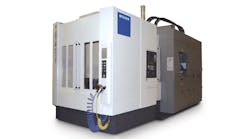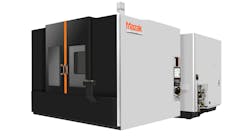The MC Series horizontal machining centers that Heller Machine Tools introduced in 2007 have earned a reputation for the productivity they afford to machine shops, but the developer notes that is a result of a “super-robust” design that establishes the structural solidity and high torque needed to make deep cuts in the toughest material, as well as the accuracy to finish machine the part.
“The capacity of the MC Series machines to make roughing cuts all day long yet finish-machine the same workpiece in the same fixture makes the line unique in the world of machining centers,” according to Heller vice president Vince Trampus, “and has a major, positive impact on the cost of machine ownership in the short and long term.”
The precision provided by all machine sizes in the MC range is ensured by reduced table deformation and high precision, due to internally arranged drives. This provides high productivity and minimal axes positioning times, resulting in 20-50% reductions in machining times in practical application, compared to competing models.
The MC Series includes machine centers in seven different sizes, each one built according to Heller Machine Tools’ century-plus design philosophy, which it noted has been has been to establish maximum reliability and material cutting versatility, such that machines are capable of rough and finish machining to exceptionally tight production tolerances over a long service life.
The developer added that the MC series is equally well suited to light-metal machining and heavy-duty machining. That applies to many automotive components, from suspension to engine blocks and heads.
Multiple extension options
The versatility of the MC series machines is demonstrated by the fact that each can be equipped with a range of optional extensions, including an out-facing slide with coupling through the center of the spindle for performing NC turning operations.
“Today’s machining center users focus on aspects such as machine construction, pallet magazine, traverse paths, process dependability, high productivity and precision,” according to Trampus. “In these terms, the MC series scores well with a very rigid build, high mechanical accuracy and Heller’s twin-drive in the Z axis, which ensures symmetric force application and free chip fall.”
For varying batch sizes and a variable range of parts and materials, the MC series machines are capable of high-speed cutting, heavy cutting, and dry or MQL machining at full productivity in series or for parallel processing. Users can specify spindle size and taper, tool magazine and chip disposal, resulting in an attractive price/performance ratio.
There is a choice of gear-driven spindles for power, speed, high-power, or power/speed provide feed thrusts — uncommon in this range of machining centers — of 15,000 N in the X and Y axes, 20,000 N in the Z axis; traverse speeds of 60,000 mm/min, and torque of up to 2,300 Nm. The high-capacity 630-mm pallet changer will handle workpieces to 900 mm dia., 1,200 mm high, weighing up to 1400 kg.
Another noteworthy benefit of the series, especially in terms of automation, is tool management. The MC series is available with a chain-type tool magazine with storage capacities for 54, 80, 160 or 240 tools, and a rack-type magazine with more than 400 storage places enabling tool-loading parallel to machining. It achieves ‘chip-to-chip’ time of four seconds or less, according to the machine builder.
Despite the high power, speed, and torque of the MC series, they are relatively energy efficient machine tools. The use of regenerative drive systems, servomotors providing a more efficient use of the overall speed range or even reduced-power valves, and standby strategies are standard features. Also effective are the speed-regulated high-pressure pumps on the machines’ coolant units.







